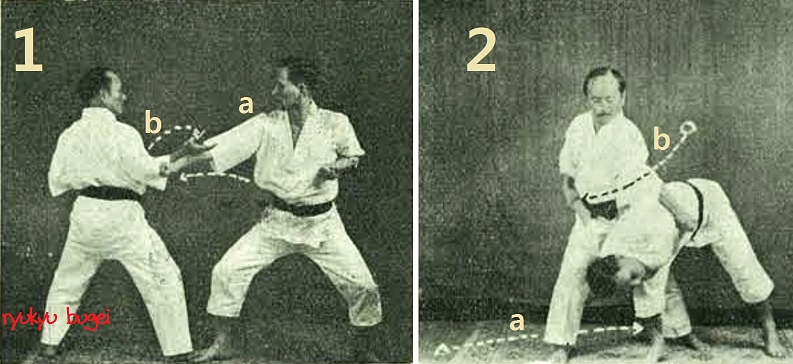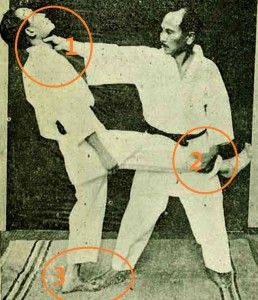Throws & locks in Karate are the scoop of the year, rightly. While discussing the topic, the perspective is usually that of the executor of a technique (tori 取り): he applies locks and throws.
But what did the initial attacker and final receiver of the technique (uke 受け) do? More specifically, what do the early sources say he does?
According to Funakoshi‘s 1925 book, the throws (nage-waza 投技) he presented there were solely designed against strikes:
In each of the six cases of throws described by Funakoshi in 1925, the opponent attacks by plunging forward. This is done either with one hand, or with both hands. There is no attack were uke uses locks & throws to attack tori.
In order to illustrate the above, I chose two techniques from among the so-called “9 Throws of Funakoshi.”(*1) To do so, I used the text from the 1925 edition, while for the photos I used the 1935 edition as they more clearly illustrate the sequence of the techniques.
1. Twist and overturn (neji-taoshi 捻倒)
The opponent plunges forward with a right thrust (1a). Receive this with a right Ura-uke (1b). Simultaneously grasps the opponent’s arm with your left hand, and while pulling the left foot backwards (2a) press him down to the ground.(*2)
By the way, a similar technique was shown by Dutch Nicolaes Petter 1674.

2. Chain ring (kusariwa 鎻環)
The opponent plunges forward with both hands towards face level (1a); ward this off with both hands to the upper level (1b). Apply scissor strike (2). Jump in front of the opponent and apply the arm ring (3).(*3)

Therefore it seems that karate locks & throws – at least from the cited source and at that time – were solely designed against strikes. If Karate is ought to fulfill its role as a grappling art, it needs to include throws & locks as methods of attacks, just like Jūdō and Jūjutsu-like systems always did.
While this is done in Karate anyway – and it is nothing new – the historical proof is still shallow as can be seen in the above cited description of Funakoshi. Strictly according to this source, Karate at the time did use locks & throws, but did not use them as methods to defend against: The methods to defend against were strike and kicks. Maybe that was what Mabuni was referring to when he said:
When talking about locks and throws they [karate people in Tokyo] assume that these only exist in jūjutsu and jūdō. This way of thinking is exceedingly counterproductive with respect to karate itself and can only possibly be attributed to a lack of knowledge.
From a research perspective there is another interesting thing to note that had been ommitted in the 1935 Funakoshi edition, and therefore also in the English translation of it: the techniques presented in the 1925 edition here were explicitly described as applications of specific Kata.
The first one is described as a “technique from Naihanchi Shodan transformed (to practical use).”
The second one is described as a “technique from Passai transformed to practical use.”
❁

Nodo-osae, making “Funakoshi’s throws” ten in total, not nine.
*1: It should be noted that 6 throws are found in the 1925 edition, 9 throws are found in the 1935 edition, and 10 is the actual set union of these. The reason for the 9 throws seems to be the sole reference to the English translation of the 1935 edition. The 10th throw is the “throat pin” (nodo-osae 咽抑) from 1925, which was not featured in 1935. Do as shown in points 1, 2, and 3 in the picture, then throw him down (remain standing on his foot and push leg up and throat foward):
*2: In the 1935 edition this technique was renamed to “spinning-top throw” (koma-nage 獨樂投).
*3: In the 1935 edition this technique was renamed to “arm ring” (udewa 腕環).
© 2016, Andreas Quast. All rights reserved.
